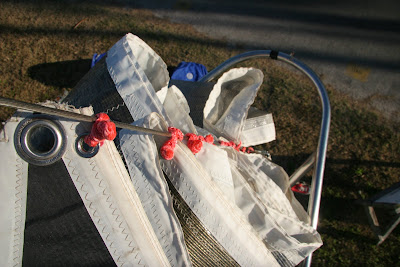After finishing a job at Speed Merchant, I started servicing the old Barient 21 primary winches from Furthur on the work bench, when I noticed the winch pawls were about to fall out of the inside of the winch drum. Over three decades of use, abuse, and probable lack of maintainence, the pawl had worn its socket in the winch drum and the pawl spring was trying to push it out. I asked Brian what he thought about pawls, and when he saw them his reaction was one of horror. The winch was essentially fragged; with any more use the pawl could wear the last bit of the socket holding it in. This would leave only one pawl to hold the entire winch load, and it would inevitably fail as well, leaving the winch useless. Not a good scenario while racing to Hawaii. The other winch was in almost as poor shape, and a replacement drum would be very difficult to find as Barient is no longer a company.
Luckily, Brian had a used set of Harken 32 winches from his J/24 in the trailer. After some discussion and haggling, I bought them from Brian and began tearing them down. Brian said they were only about 5 years old and had been rebuilt every year. He showed me the correct way to rebuild a winch, and using gasoline to dissolve the old winch grease, and each piece was soon clean. The most common mistake in servicing winches is to use too much grease, making them hard to spin when unloaded. The key is to use just enough grease on the bearings and a light oil on the pawls and pawl springs. After watching Brian service the first winch, I did the second one exactly as shown. I initially used too much grease on the bearings and had to wipe some off to make the winch free-spin easily, but other than that the servicing went well and I know the winches inside and out.
The downside of the new Harkens was they did not have the same bolt mounting pattern as the old Barients. Therefore I had to fill all the holes and re-drill them. Because the Santa Cruz 27 has a Balsa-cored deck, it is crucial that any holes drilled for fasteners be water tight. Even if the fastener is bedded in 4200 (a type of marine sealant), the cured 4200 could eventually tear and allow water into the core. Therefore, it was necessary to go over-kill on the new winch installation.
After using the winch as a template, I drilled the new holes. This is always never-wracking, as you are DRILLING HOLES IN YOUR OWN BOAT, but also fun in a weird way. I then over-sized the new holes to 3/8" (the winch is mounted with 1/4" bolts) and put masking tape under the holes. The reason behind this is to keep water out of the core, you fill the over-size hole with epoxy thickened with filler, then when the epoxy is cured, drill the correct size hole for the fastener in the epoxy/filler plug. The epoxy plug separates the fastener hole and core, keeping the balsa dry and the decks strong.
I did this with Sheehan's help; she loves working with epoxy and fiberglass. I hate it. We even added a step to the epoxy process to further seal the core. First, she injected just epoxy into the holes with a syringe, then sucked it out before it cured. This is because unthickened epoxy will better penetrate and seal the balsa wood. Next, Sheehan filled the holes with thickened epoxy for a stronger plug.
When the epoxy had cured, I drilled the 1/4" holes, and bolted in the Harken 32s. I used some 4200 out of habit, but it may have been unnecessary. The new winches are excellent, they free spin more easily, have a lower 2nd gear ratio for more power, and far more abrasive material on the winch drums. This was a huge issue with the old Barient 21s, even with 4 wraps on the winch the line barely held.
I also got to try out the new soft hanks on the Thursday Night Full Moon Race and they work very well. The jib was no longer at risk of pulling out of the heafoil, sets and douses were fast, and it was easy to control the draft of the sail with halyard tension. The only issue with the soft hanks is they can be hard to get on and off. It will be interesting to see of this gets better or worse with time. It would probably be best to get bronze hanks for the sails we'll be taking on Pacific Cup, but for now the soft hanks are cheap and work.
The wind for the race was very light and we had a bad start in lee of all the big boats. While tacking to get clear air, there was such a massive wind shift that we actually aborted the tack. This put us behind the fleet at the first mark, but we began to catch back up reaching with the spinnaker. Unfortunately, this was the only leg we could fly the kite on and we had a close reach/beat to the finish. There were a few funky wind shifts near the finish that we probably could have played better, but sailing at night without local knowledge makes calling the geographical shift difficult. Arthur did put each DIYC race mark in the GPS before the start, which helped keep us from getting lost during the race. Time in the boat will also help our speed. We corrected out second to last, but nothing broke and everyone had fun so it was a good race.
Subscribe to:
Post Comments (Atom)




No comments:
Post a Comment